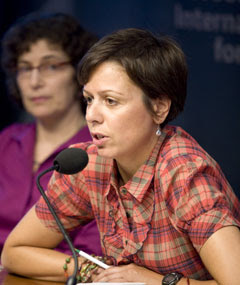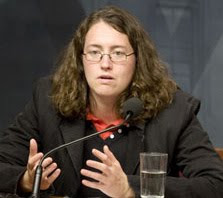Showing posts from category media.
-
Climate-Security Gets “To the Point” Today
›Today’s episode of NPR’s “To the Point” with Warren Olney will focus on “Global Warming and the Geo-Political Map,” seeking to answer the question, “What are the risks to natural resources, immigration, and political stability worldwide?”
As one of the four panelists, ECSP Director Geoff Dabelko will draw on his recent article in the Bulletin of Atomic Scientists and ECSP’s climate-security resources.
Climate security has been heating up the media for the last few months, although most news coverage has been rather thin. That’s understandable, given the complexity of the drivers involved, and the crushing constraints on environmental reporters’ time and budgets these days. But climate security is a politically powerful argument, one which advocates from all over the political spectrum have increasingly adopting, and it deserves a more thorough, thoughtful treatment.
“Come to Attention,” a panel at this year’s SEJ annual conference (audio) moderated by ClimateWire’s Lisa Friedman, delved into some of the finer points of this often oversimplified connection. As part of the panel, Dabelko outlined seven cautions to keep in mind and suggestions for improving coverage of the difficult link.
While Grist’s Robert McClure jokingly called the session “doom and gloom without the sense of humor,” Dabelko ended on a positive note, pointing out that by coming together to battle climate change, countries may build bridges to peace, rather than war–particularly if the militaries cooperate in the fight.
In a recent op-ed, Dabelko and the U.S. Army War College’s Kent Butts argue that climate could be one of the most productive avenues for improving military relations with China, suggesting that “U.S. and Chinese militaries should jointly assess the security implications of climate change that concern both sides: rising sea levels, changing precipitation patterns, uncertain migration scenarios, and instability in resource-rich regions.”
“To the Point” airs live online at 3 PM EST. In the Washington, DC, area listen to it at 10 PM EST tonight on WAMU 88.5. -
Reporting From Kenya: U.S. Editors Cover Health, Environment, and Security
›November 4, 2009 // By Sajid Anwar The global recession has “been very hard on journalists,” explained Andrea Crossan, radio producer for BBC’s “The World”. “With these kinds of cutbacks, you really feel it when it comes to foreign coverage.” Along with Stephanie Hanson, associate director and coordinating editor of CFR.org, and Margaret McElligott, senior producer for washingtonpost.com, Crossan spoke about the International Reporting Project’s (IRP) Gatekeeper trip to Kenya at a Wilson Center event sponsored by the Environmental Change and Security Program.
The global recession has “been very hard on journalists,” explained Andrea Crossan, radio producer for BBC’s “The World”. “With these kinds of cutbacks, you really feel it when it comes to foreign coverage.” Along with Stephanie Hanson, associate director and coordinating editor of CFR.org, and Margaret McElligott, senior producer for washingtonpost.com, Crossan spoke about the International Reporting Project’s (IRP) Gatekeeper trip to Kenya at a Wilson Center event sponsored by the Environmental Change and Security Program.
“You’ve seen a lot of areas of the world that just aren’t getting the coverage these places deserve, and Africa is one of those places,” said Crossan, partly due to the expense of travel, security, and satellite equipment. IRP, a project of The Johns Hopkins University’s School of Advanced International Studies, aims to fill gaps in foreign reporting left by extensive budget cuts by offering U.S.-based editors and journalists opportunities to report on international stories.
“I’ve traveled a fair amount with the BBC, and I’ve seen some really difficult living conditions for people. I’ve never seen anything like I’ve seen in Kibera,” said Crossan. “We can look at all of the things we are talking about today”—environment, health, security—“through what’s happening in Kibera.”
Poverty and Pirates
At a meeting at the University of Nairobi, a student criticized foreign reporting of Kenya, saying that it “only seems to cover poverty and pirates,” said Crossan. That’s a slight improvement over previous years, when U.S. coverage focused on “witches and war,” noted an audience member.
McElligott, who previously worked for AllAfrica.com, agreed that U.S. media coverage of Africa is becoming richer, with fewer instances of racism accompanying reporting. “The world is so much smaller now,” with email, Facebook, blogs, and video providing additional venues and in-country contacts, she said.
The Kenyan press is the “most trusted institution” in the country, said Hanson. They expose corruption, report on health issues, and call the government to task. With the decline in U.S. journalists posted abroad, the support and stories provided by Kenyan reporters is crucial to getting coverage in the international media.
While pitching international stories to U.S. audiences might be a hard sell, “if it’s a good, compelling story, it will go up in a prominent place” with or without a U.S. angle, said McElligott. “It’s just about telling human stories,” said Crossan.
Kenya on the Edge: Drought and Conflict “In the last months we’ve seen the food crisis grow in Kenya,” said McElligott. On the group’s visit to Laikipia, she noted the impacts of soil degradation, unsustainable water extraction from rivers, and the lack of governmental regulation. Lack of land and water is forcing pastoralists to travel miles away from home in order to feed cattle and goats.
“In the last months we’ve seen the food crisis grow in Kenya,” said McElligott. On the group’s visit to Laikipia, she noted the impacts of soil degradation, unsustainable water extraction from rivers, and the lack of governmental regulation. Lack of land and water is forcing pastoralists to travel miles away from home in order to feed cattle and goats.
“We’re desperate for water here,” said Laikipia resident Niyok Npanyaki in an IRP video report. “We’ve decided that if water is cut off, we’ll go to the water source on Mount Kenya, even if the government doesn’t let us. Otherwise we will die. People don’t start wars for no reason. If I am hungry, but if you have food, I’ll come to you and find it.”
“Loss of natural resources puts people under extreme pressure and people will go to extreme lengths in order to get those fundamentally important natural resources,” says Dr. Anthony King, director of Laikipia Wildlife Forum, in the video. Adding to the tension between farmers and pastoralists is the easy access to firearms in the Horn of Africa. “Almost every pastoralist will have an automatic weapon,” says King.
The IRP fellows visited the headquarters of the UN Environment Programme in Nairobi, but found it difficult to gauge the effectiveness of UNEP at addressing Kenya’s drought and deforestation. According to Crossan, UNEP has invested in a number of local programs, but the UNEP officials they spoke with seemed frustrated that the Kenyan government was not more involved in tackling the country’s environmental problems.
“Something I struggle with in my own work is trying to understand what actual effect these large multilateral agencies have on the ground. What is the World Bank actually doing in Ghana? What are they actually doing in Kenya?” said Hanson. “Does the money get distributed? Who does it go to? Having more Kenyans or Ghanaians who could report on these things and look into them in terms of transparency and accountability would be incredibly helpful.”
Malaria: A Disease of the Poor “Malaria was, to be honest, not a disease that was really on my radar,” said Hanson. “I had, in a way, discounted its importance to what has happened on the continent.” At a children’s critical care unit in Nyanza Province, one of the poorest areas in Kenya with one of the highest rates of HIV and malaria, she saw beds filled with sick children. “This was shocking to me.”
“Malaria was, to be honest, not a disease that was really on my radar,” said Hanson. “I had, in a way, discounted its importance to what has happened on the continent.” At a children’s critical care unit in Nyanza Province, one of the poorest areas in Kenya with one of the highest rates of HIV and malaria, she saw beds filled with sick children. “This was shocking to me.”
When a family member is stricken with malaria, the burden of care is typically falls upon the mother, who often must travel long distances to the nearest hospital—“some of them had walked hours with a sick child,” said Hanson—leaving their other children at home and farms largely untended.
“When these women have to leave their farms to come to the clinic, they’re losing work days on the farm,” said Hanson. “That just means that their farms are less productive. They have less money to send their children to school, give their children medical care, and feed their children.”
“These macro-political issues—disputed elections, post-election violence—are actually connected to daily issues like malaria infections, hospital capacity rates, agricultural yields, and without a government that can address those things it is very difficult to see how a place like Kenya can move forward,” concluded Hanson.
Drafted by Sajid Anwar and Meaghan Parker.
Edited by Meaghan Parker. -
If It Bleeds It Leads: Pop-Climate Hits the Blogosphere
›Population and climate change get short shrift in the media—that is, until Rush Limbaugh urges you to commit suicide. It’s a disturbing sign that this extremely complex topic only gets play when the knives come out. And as this summer’s health care circus demonstrates, the blogosphere is often more interested in covering the shouting than the issues at hand.
So what happened? At the Wilson Center last week, the New York Times’ Andrew Revkin (via Skype) mentioned a thought experiment he had put forward in a recent post on his blog: “Should you get credit — if we’re going to become carbon-centric — for having a one-child family when you could have had two or three. And obviously it’s just a thought experiment, but it raises some interesting questions about all this.”
Limbaugh, picking up on a post on CNS.com, a conservative online news outlet, said Revkin and “militant environmentalists, these wackos, have so much in common with the jihad guys.” The furor was reported by a number of news blogs, including NYT’s Paul Krugman, the Guardian, and Politico.
An earlier and more substantial account by Miller-McCune’s Emily Badger deftly hits the highlights, including some historical context from The Nation’s Emily Douglas. While earlier projections assumed population growth would decline following the dissemination of birth control in the West, “that assumption turned out to be false,” said Douglas, because women in developing countries have not received similar access to contraceptives.
Indeed, as Worldwatch Institute’s blog post on the event points out, “an estimated 200 million women who want to avoid pregnancy are risking it anyway because they have inadequate access to contraception and related reproductive health services.”
I’m disheartened that this kerfluffle follows a recent uptick in thoughtful coverage of the population-climate connection. At a standing-room-only panel (audio) on covering population and environment at the most recent SEJ conference, Baltimore Sun reporter Tim Wheeler (video) said that population “has those challenges of so, what do you do about it, how do you deal with it.” But he said it was reporters’ “constant challenge to continue to wrestle with these issues.”
Moving the wrestling match into the center ring is bringing a new focus to the debate, which could be useful, as Suzanne Petroni writes in the ECSP Report: “A careful discussion of the ways in which voluntary family planning can further individual rights, community development, and, to some extent, climate change mitigation, could increase awareness not only of the outsized contribution of developed nations to global emissions, but also of their appropriate role in the global community.”
As Revkin says at the end of his response to Limbaugh: “And of course there’s the reality that explosive population growth in certain places, particularly sub-Saharan Africa, could be blunted without a single draconian measure, many experts say, simply by providing access to family planning for millions of women who already want it, but can’t get it – whether or not someone gets a carbon credit in the process.”
Family planning advocates—who have long been wary of linking contraception to climate mitigation—would mostly agree with that statement, although they would phrase it a little differently. Better reproductive health care is “an end in itself,” with climate mitigation being the “side effect,” rather than the primary goal, Barbara Crossette writes in The Nation.
Population experts cautiously agree there is a link, but warn that quantifying it is not so simple. At a major conference of demographers in Marrakesh, researchers previewed forthcoming research described the potential for emissions “savings” brought by decreases in fertility.
In the near term, it doesn’t look likely that all this attention will lead to policy action at Copenhagen. Population Action International reports that while almost all of the least developed countries’ adaptation plans mention population as a factor which increases their vulnerability to climate change, only a few state that investing in family planning should part of their strategy.
I encourage you to watch the webcast of the event and add your own (thoughtful) comments to the dialogue below. No suicide threats, please. -
Population’s Links to Climate Change
›“Covering Climate: What’s Population Got to Do With It?”—webcast live from the Wilson Center—will analyze the challenges facing science and environmental reporters as they prepare to cover what New York Times reporter Andrew Revkin calls “the story of our time.” Cosponsored by the Society of Environmental Journalists and the International Reporting Project, the panel—including Dennis Dimick of National Geographic and the Nation’s Emily Douglas—will discuss the significant barriers to nuanced reporting, including stovepiped beats, the shrinking news hole, and old-fashioned squeamishness.
However, in the past month, there’s been a veritable baby boom of news coverage on climate change and population. Spurred by three high-profile reports—the study commissioned by the Optimum Population Trust, research in the Bulletin of the WHO, and an editorial in the Lancet—the mainstream media and some key bloggers finally got some condoms in their climate change.
It’s gratifying to finally see this issue pop up in the media, almost a year to the day after the 2008 SEJ conference panel on population and climate change moderated by Constance Holden of Science that attracted a respectable (but not remarkable) audience of 40. The panelists decried the media’s relative silence on the impact of population growth and other demographic dynamics on environmental issues.
NPR’s Steve Curwood pointed out that while it’s “something we don’t talk about at all in America,” U.S. population growth increases emissions faster than developing-country population growth, due to our larger per capita consumption. A lone AP article, “Population growth contributes to emissions growth,” reported on the discussion.
In contrast, a population-climate panel at last week’s SEJ conference drew an overflow crowd of more than 100 people. Former SEJ President Tim Wheeler read off recent headlines demonstrating that the media does mention population. However, he noted that “most of the instances I cited are op-ed opinion pieces, not news coverage or feature stories.” In recent climate coverage, he said, “population gets mentioned as an undercurrent and afterthought; our attention intends to be on the immediate. And it has those challenges of so, what do you do about it, how do you deal with it.” But it is “our constant challenge to continue to wrestle with these issues.”
Here’s a short list of recent coverage:
Associated Press: “Birth control could help combat climate change”
Reuters: “Contraception vital in climate change fight -expert”
Bloomberg: “African Condom Shortage Said to Worsen Climate Impact”
Matt Yglesias: “Population and Climate Change”
The Nation: “Factoring People Into Climate Change”
Inter Press Service: “POPULATION: Where’s Family Planning on Climate Change Radar? Zofeen Ebrahim interviews noted social demographer KAREN HARDEE”
The New Republic’s The Vine: “Abortion: The Third Rail of Climate Policy?”
Treehugger.com: Contraception Five Times Less Expensive Than Low-Carbon Technology in Combating Climate Change
Washington Post: “When It Comes to Pollution, Less (Kids) May Be More”
Inter Press Service: “CLIMATE CHANGE: Rising Seas Demand Better Family Planning”
LA Times Booster Shots blog: “Can condoms combat climate change?”
-
VIDEO: Geoff Dabelko on Environment and Security at Society of Environmental Journalists Conference
›October 9, 2009 // By Sean PeoplesThe 19th annual Society of Environmental Journalists (SEJ) conference began today in the crisp autumn air of Madison, Wisconsin. ECSP Director Geoff Dabelko discusses Al Gore’s keynote address explicitly connecting climate change to national security issues, as well as his questions and expectations as the country’s premier gathering of environmental journalists gets underway.


 The global recession has “been very hard on journalists,” explained
The global recession has “been very hard on journalists,” explained  “In the last months we’ve seen the food crisis grow in Kenya,” said McElligott. On the group’s visit to Laikipia, she noted the impacts of soil degradation, unsustainable water extraction from rivers, and the lack of governmental regulation. Lack of land and water is forcing pastoralists to travel miles away from home in order to feed cattle and goats.
“In the last months we’ve seen the food crisis grow in Kenya,” said McElligott. On the group’s visit to Laikipia, she noted the impacts of soil degradation, unsustainable water extraction from rivers, and the lack of governmental regulation. Lack of land and water is forcing pastoralists to travel miles away from home in order to feed cattle and goats. “Malaria was, to be honest, not a disease that was really on my radar,” said Hanson. “I had, in a way, discounted its importance to what has happened on the continent.” At a
“Malaria was, to be honest, not a disease that was really on my radar,” said Hanson. “I had, in a way, discounted its importance to what has happened on the continent.” At a 

